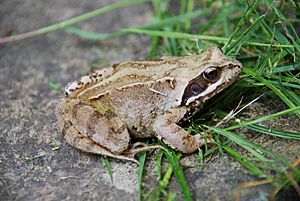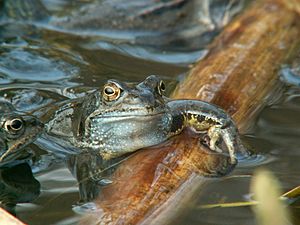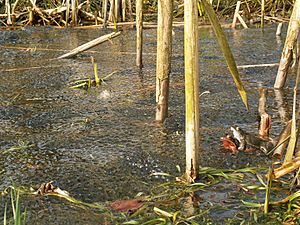Common frog facts for kids
Quick facts for kids Common frog |
|
|---|---|
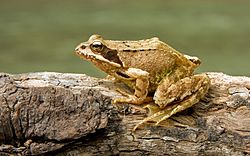 |
|
| Conservation status | |
| Scientific classification | |
| Kingdom: | |
| Phylum: | |
| Class: | |
| Order: | |
| Family: | |
| Genus: | |
| Species: |
R. temporaria
|
| Binomial name | |
| Rana temporaria Linnaeus, 1758
|
|
| Subspecies | |
|
|
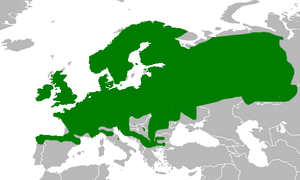 |
|
| Distribution of Rana temporaria in Europe | |
The common frog (Rana temporaria), also called the European common frog, is a type of amphibian. It lives partly in water and partly on land. You can find it across much of Europe, from Scandinavia in the north to the Urals in the east. It also lives in Ireland and parts of Asia, all the way to Japan.
Common frogs go through three main life stages. They start as larvae (tadpoles) in water. Then they become young frogs that live on land. Finally, they grow into adult frogs. They have round bodies, webbed feet, and long back legs. These legs help them swim well and hop on land. People sometimes confuse common frogs with common toads. But frogs have longer legs and moist skin, and they hop. Toads crawl and have dry, bumpy skin.
Contents
What Does a Common Frog Look Like?
Adult common frogs are about 6 to 9 centimeters (2.4 to 3.5 inches) long. Their skin color can change to match their surroundings. They might be olive green, brown, grey, or yellowish. Some rare frogs can even be black or red. There are also albino frogs, which are yellow with red eyes.
Male frogs change color during mating season. They often turn a greyish-blue. Females are usually a bit bigger than males. The average weight of a common frog is about 23 grams (0.8 ounces).
Common frogs have dark spots on their backs and sides. They often have a V-shaped mark on their neck. There's also a dark spot behind each eye. Their belly is usually white or yellow, sometimes with brown or orange spots. Their eyes are brown with horizontal pupils. They have clear inner eyelids that protect their eyes underwater.
Male frogs have special rough pads on their front legs. These are called nuptial pads. They use them to hold onto females during mating. During this time, males' throats often turn white. Females tend to be browner or even reddish.
Where Do Common Frogs Live?
Common frogs live in many parts of Europe. They are found as far north as the Arctic Circle in Scandinavia. They also live east to the Urals. You won't find them in most of Spain and Portugal, southern Italy, or the southern Balkans. They have also been introduced to places like the Isle of Lewis, Shetland, Orkney, and the Faroe Islands. They are also found in Asia, reaching as far as Japan.
For a long time, people thought all common frogs in Ireland were brought there by humans. But recent studies show that some frogs in southwest Ireland are actually native. This means Ireland might have a mix of native frogs, frogs that moved there naturally after the last ice age, and frogs brought by people.
What Do Common Frogs Eat?
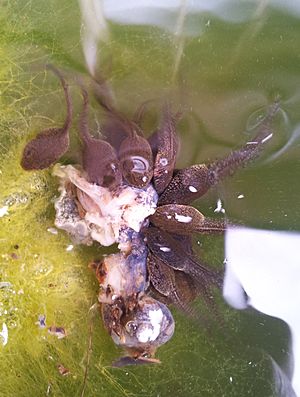
When they first hatch, tadpoles mostly eat plants. They feed on algae, tiny bits of dead plants, and small water creatures. As they grow and their back legs appear, they become meat-eaters. They will eat small animals or even other tadpoles if food is scarce.
Young frogs eat small creatures both on land and in water. But as they get older, adult frogs only eat on land. Adult common frogs will eat any invertebrate (animals without backbones) that is the right size. They catch their food with their long, sticky tongues. During the short breeding season, they don't eat at all. Their favorite foods include insects (especially flies), snails, slugs, and worms.
Habitat and Habits
When it's not breeding season, common frogs live alone. They like damp places near ponds, marshes, or in tall grass. They are usually active for most of the year. They only hibernate (sleep through winter) during the coldest months. In very cold northern areas, they might be stuck under ice for up to nine months. But even then, they can be somewhat active at temperatures near freezing.
Common frogs hibernate in flowing water, muddy burrows, or under layers of leaves and mud at the bottom of ponds. Their skin can take in enough oxygen to keep them alive while they are cold and still.
Life Cycle and Reproduction
In spring, changes in things like rain, daylight, and temperature tell the frog's body to make hormones. These hormones help females produce eggs and males produce sperm. The male's nuptial pads also get bigger and darker.
Common frogs breed in shallow, still, fresh water, like ponds. This usually happens between March and June, but often in April. Adult frogs gather in the ponds. Males make loud "croaking" sounds to attract females. Females are drawn to the males with the loudest and longest calls.
Conservation Status
Common frogs can get sick from diseases like Ranavirus and a fungus called Batrachochytrium dendrobatidis. This fungus has caused many amphibian species to disappear around the world. Losing their homes (habitat) and these diseases have caused common frog numbers to drop in Europe. However, the common frog is currently listed as a species of Least Concern on the IUCN Red List of Threatened Species. This means they are not currently in danger of disappearing.
Who Eats Common Frogs?
Tadpoles are eaten by fish, beetles, dragonfly larvae, and birds. Adult frogs have many predators. These include storks, birds of prey, crows, gulls, ducks, terns, herons, pine martens, stoats, weasels, polecats, badgers, otters, and snakes. Some frogs are killed by domestic cats, but cats rarely eat them. Many frogs are also killed on roads by cars.
Images for kids
See also
 In Spanish: Rana bermeja para niños
In Spanish: Rana bermeja para niños



